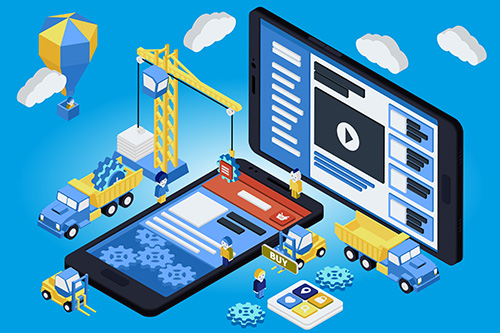Hosted services and the cloud offer big opportunities for construction companies to offset some of the time and expense associated with large technology deployments. Now, many engineering and construction companies are moving to the cloud to drive greater innovation both in the office and at the jobsite.
Think of the whole project lifecycle as being digitized—from estimating, to scheduling, to risk analysis, to computer-aided design (CAD), and building information modeling (BIM), suggests Stacey Witt, chief marketing officer, LoadSpring Solutions.
Anchoring Tech Solutions in the Cloud
The challenge is not always easy or quickly achieved, which is why many construction companies are turning to the cloud and software-as-a-service (SaaS).
“Every fortune 100-500 company we talk to is looking towards the cloud as a critical anchor for the tech solutions,” explains Witt. “SaaS solutions and multicloud or generic cloud deployments are risky. Look to someone with industry expertise, app expertise, and tech infrastructure experience where you can consolidate your project tech in one location.”
She goes on to say this will provide better control, more efficient access, improvement adoption, and better support, which will ultimately improve margins and competitiveness.
This is in line with tech trends happening today. Cisco’s Global Cloud Index shows that by 2021, 94 percent of workloads and compute instances will be processed by cloud data centers, while 6 percent will be processed by traditional data centers.
Further, it shows that most of the more than 850 ZB of the data generated by 2021 will be ephemeral, meaning it will be neither saved nor stored. Useful data will exceed data center traffic by a factor of four. Cisco suggests edge or fog computing could help bridge this gap.
 Understanding the Cloud
Understanding the Cloud
Back in 2011, the National Institute of Standards and Technology (NIST) first defined cloud computing to help businesses understand what it is.
The definition said cloud computing is “a model for enabling ubiquitous, convenient, on-demand network access to a shared pool of configurable computing resources (e.g., networks, servers, storage, applications and services) that can be rapidly provisioned and released with minimal management effort or service provider interaction."
This includes five essential characteristics of cloud computing:
- On-demand self-service
- Broad network access
- Resource pooling
- Rapid elasticity or expansion
- Measured service
This definition also includes three service models:
- Software
- Platform
- Infrastructure
Finally, it includes four deployment models:
- Private
- Community
- Public
- Hybrid
Since that time, edge and fog computing have also become more common terms. Edge computing, also known as fog computing—a term coined by Cisco—is a method of optimizing cloud computing systems by performing data processing at the edge of the network. This can help analyze data, while addressing the influx of data that is coming.
For construction companies, this is important because the emergence of this technology is impacting how work is being done out at the job site.
“Tools are now available that can provide easy access to the applications needed,” explains Witt. “Think the cloud. So team members at the jobsite can access and report on scheduling changes so projects can increase their success.”
In construction, this can mean faster response time, improved output, heightened service levels, and increased safety on projects.
Wes Smith, president, AEC Cloud, explains that the technologies that are having the biggest impact on the construction industry today include handheld devices, data integration, and large cloud platforms. This includes Azure, Amazon Web Services, and Google.
One of the big challenges here for many construction companies is creating a strategy and implementation of the strategy.
 A Plan for Cloud Adoption
A Plan for Cloud Adoption
A general consensus among many of the players in the space is that there is not a one-size-fits-all approach to cloud technologies. Each implementation is different based on the needs of the organization.
The first step is to get buy in from everyone involved—from the office to the job site. Smith says good strategies revolve around the people, experienced project managers, engineers, and enthusiastic adopters.
Witt agrees, saying, “You need buy in and adoption at the end so you do not have shelf wear vs. adoption of best-in-industry solutions.” She goes on to say that what she sees often is a strategy with no resources or buy in to execute it.
Often, a good partner can help make it easier, especially as IT departments are becoming more burdened with the growing amount of technology within a company.
After buy in is achieved, a few other key steps are critical to ensure success. This includes
- Creating a cloud strategy
- Designing a cloud-based architectural model
- Making the transition to the cloud
- Training workers on how to use the technology
“Configuring and implementing solutions that work and then training appropriately is critical to adoption and increased time to value for the investment that is being made,” says Witt.
Once this happens, team members at the construction job site will have access to information more readily than in the past.
When it comes time to implement solutions and train operators, Smith of AEC Cloud recommends looking for organic sprawling adoption to indicate easy wins. “Bite off reasonable chunks of scope that can result in 60 to 90 day wins.”
Hosted services and the cloud are a big value for construction companies today. It can help outsource some of the technology management, so contractors can focus on the work being done in the field.
Access to real-time data at the construction project gives workers more control to improve efficiency on the job. First, construction companies need to understand what the technology is, and then they need to create a strategy for adoption, which includes getting buy in, making the transition, and training workers.
This will lead to more productivity and greater safety at the construction jobsite, which will ultimately improve the bottom line.












